#region: australia
Explore tagged Tumblr posts
Text
No. 46 - Royal Flying Doctor Service
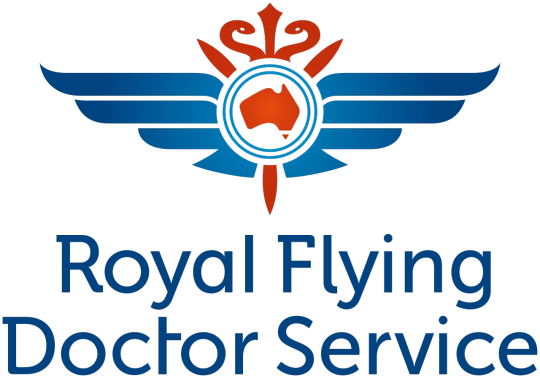
In contravention of my normal operating procedures I've fast-tracked this request to the front of my queue because of how fantastically timed it is. It was requested the day my BermudAir post went up, and the moment I saw it I realized I was going to publish it as the next entry on this blog, because I want to highlight something really important and really positive about aviation. So thank you @alionessespride for the impetus to discuss why aviation is genuinely indispensable, regardless of what cynical things people might use it for.
My most recent post on BermudAir is definitely a major downer, and other posts I've done, like my David Neeleman special and various other assorted brief allusions, have been really distinctly pessimistic and jaded about the motivations of airlines. Which I don't regret or think is bad or wrong - these are very omnipresent specters in the airline industry, which is inherently more than a little predatory both due to its necessity for profit and its very heavy ties to the military-industrial complex, with airlines, governments, and manufacturers ending up in elaborate daisy chains of sweetheart deals and making money being sort of incompatible with anything I'd consider a virtue.
But I went on about this in my Neeleman post and sort of alluded to it with BermudAir as well - aviation isn't just that, and it's really hugely important. In addition to the sheer fact that people who live on islands or in remote places with poor infrastructure can easily access the rest of the world, aviation provides a lot of important services - weather research/surveillance, aerial firefighting, aerial inspection of things like power lines, agricultural work, greatly increasing the speed and thoroughness of search and rescue, and of course air medical services.
If you live in a major city you probably get a handful of ambient helicopters (I've been told a lot of people find them annoying because they tend to fly quite low), and if you've ever wondered what they are, they're probably medevac helicopters. There's a chance they're news, or private helicopters, or something else, but most of the time they're there to airlift people to hospitals if their condition is too dire to wait for the length of time an ambulance would take to get them to the trauma center, and a helicopter can easily land in a small, precise area and bring them there.
Which is all well and good, but that's for large cities. But most of the world actually isn't large cities. Case in point: most of Australia is borderline empty.
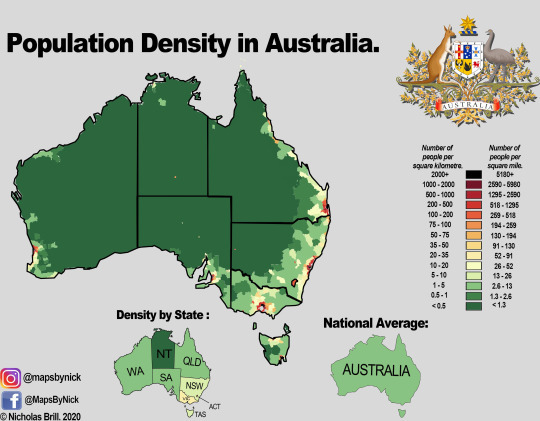
Most of Australia is on par with places like Alaska. While it's overall the fourth least dense country in the world, that density is wildly skewed and the best thing I can say for the dark green section is that it's still denser than Greenland, but not denser than Mongolia. Safe to say you aren't getting an ambulance if you live in there. So what if you have an acute medical problem which needs immediate attention to prevent your death?
The Royal Flying Doctor Service (RFDS) is probably the best-known aeromedical service. It was the first such organization, nearly 100 years old, established in 1928. They provide medical services, particularly in medical emergencies, to the parts of Australia where getting someone to a hospital would probably otherwise take days. They also provide telehealth services, transfer of patients between hospitals, and transport general practitioners to places which lack access to primary care, among other things.
The initial ask requesting them outlined a lot of this:
RFDS is an absolute lifeline in rural, regional, and remote Australia, staffed with flight doctors and nurses that fly out 24/7/365. Often they land on runways that are actually just roads or dirt strips, sometimes with the runway lit up for a night landing with rolls of toilet paper dipped in kerosene and lit on fire. They move patients that may be many many hours from any medical service, as first responders to an incident or as a medical evacuation service for small hospitals to big city hospitals.
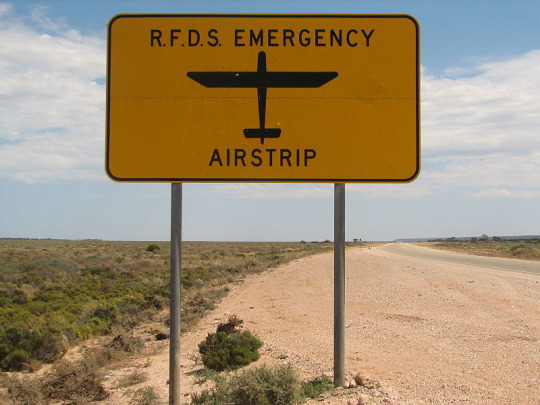
It takes a special kind of skill to land a plane somewhere like this, and an even more special kind of skill to do paramedic work while someone is landing the plane you're in somewhere like this.
While initially RFDS just rented their airplanes and pilots from Qantas, these days they have their own fleet and pilots, and while it's hard to find exact numbers because of their several regional branches their planes number in the triple-digits and are mostly small-to-medium and capable of operation on very short, poorly-equipped airstrips (STOL). The most-used models are the Pilatus PC-12 turboprop, Pilatus PC-24 very light jet, and Beechcraft King Air 200 twin-turboprop.
They have a couple of different liveries, presumably varying by time and branch, so I'm going to stick with one I think is both more visibly distinct and more current.
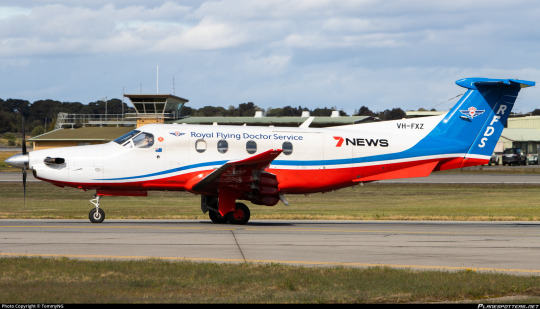
Here's a fairly standard example of this livery. The 7NEWS sticker is, I believe, a sponsor - there are different ones on different planes. As you can see, the livery is primarily red, white, and blue, which I suppose is fair enough for a non-profit service in a country with a flag based on the Union Jack, though I still find it a bit of a pedestrian choice. That said, it's at least quite an ambulancey color scheme, though it's missing giant strobe lights and a siren. I think you could install those on a plane (I mean, strobe lights are actually mandatory, just not that type) but I feel like you also shouldn't, and this is better.
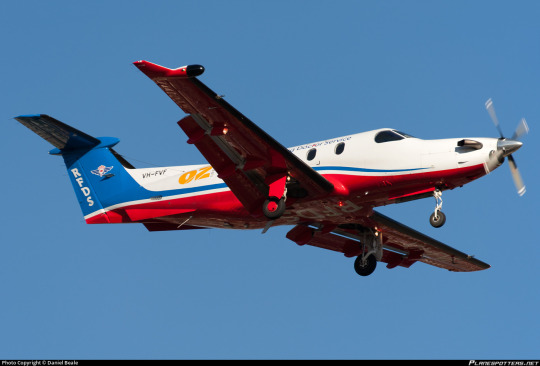
Here's a view from below, so you can see the clear and bright underside with RFDS emblazoned very visibly on it. Being easy to spot and identify is a broadly desirable trait in an emergency medical vehicle, and I love their specific choice in shade of fire-engine red. Note also the suspension on the landing gear and the weather radar on the wing facing towards the camera. The PC-12 is an incredibly designed aircraft which is popular for good reason, and is very well-suited to exactly what the RFDS is doing.
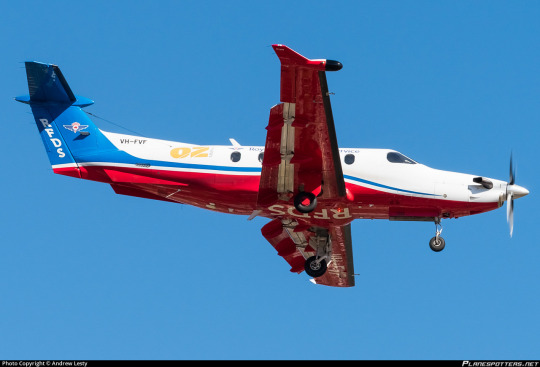
The white is used in a very interesting way, where the transition between it being a dividing line separating red from blue and the main body of the aircraft with the blue as just a swash is very very subtle, and the taper of the red is extremely well-executed. The red underside is excellent because it specifically prevents the blue and white from blending in with the sky, which wouldn't be ideal.
The Royal Flying Doctor Service and/or RFDS name is placed in three distinct places - the underside, the rudder, and above the windows. My gripe is that I wish they were a little bigger and more visible, I think. I'm not sure about the rudder, but I think a relatively easy fix would be to make the text above the windows bold and red - perhaps they just wanted to sequester the red fully to the bottom of the plane rather than having it on both sides of the blue, which I understand but don't think I fully endorse.
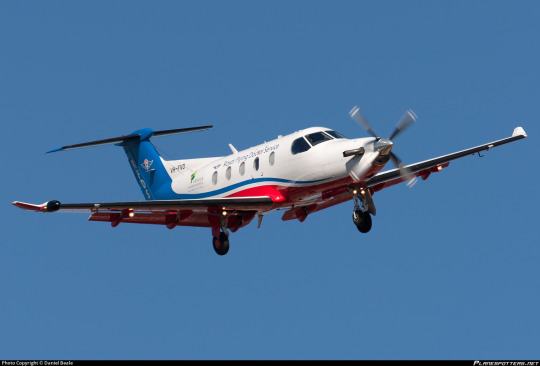
Another great view of how the red tapers, though, and the blue's termination just below the nose, far enough back that the end is still clearly visible behind the propeller. I've always felt like PC-12s (and similar single-prop aircraft but for some reason especially the PC-12) look like they have a moustache, and this adds a pair of whiskers. I enjoy that.
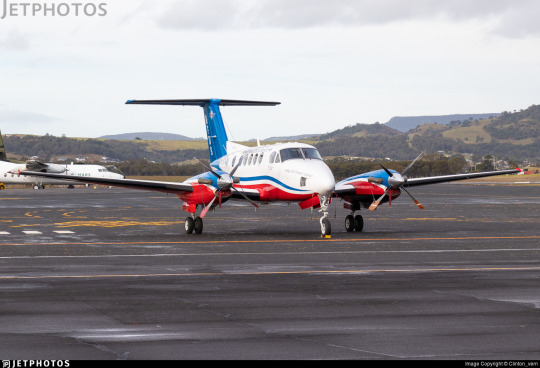
Admittedly, with the painted nacelles on the King Air something about it can begin to get a little...plastic-looking, I don't have any way to word it better. The blue in general isn't my favorite - unlike the saturated red's strikingness, it just sort of looks over-saturated in a way that I dislike. I'm not sure what would fix this. Maybe a darker blue?
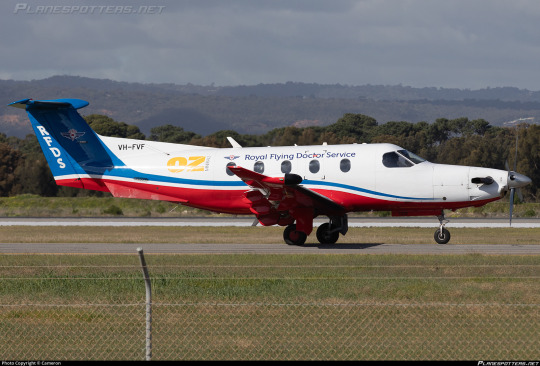
Now, the RFDS's livery is by far the least worth-discussing thing about them. The service that they provide goes way beyond appearances, and because of that and because of the fact that designing liveries for smaller planes like this begins to get difficult I'm going to not be as harsh to them as I would other subjects. I'm just not really going to take into account the fact that this is a pretty generic scheme, because that's fine, there's no reason to care. My main takeaways are that the placement of the colors is quite well-executed, and that I wish the wordmark on the main fuselage body was more distinct. In photographs it's honestly downright illegible, and the text on the rudder doesn't exactly pop out either. The tailfin, in general, looks a little cluttered, like they didn't want to leave it empty but couldn't figure out what to do with it - the RFDS text doesn't even appear centered. But at the very least it's visible, which is crucial for an air ambulance service. Maybe I wish there was less white, but there's enough red and blue, and it's bright enough, so it's done its job.
That said, I'm giving them a C.
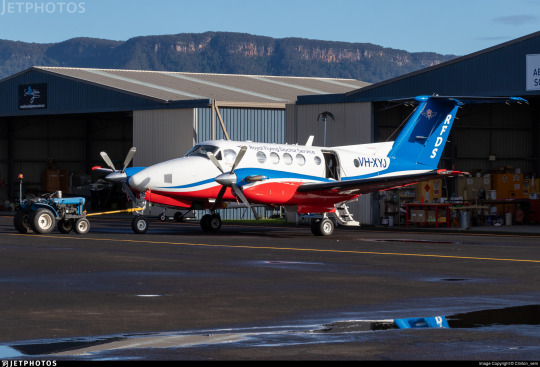
This is exactly what I expect of them. They've done a completely adequate job, and probably in a roundabout way it's good they've been spending their money on things that aren't genius graphic design. So if you have anything to take away from this post, don't have it be the grade, or even the fact that the Pilatus PC-12 is a really fantastic airplane - have it be the fact that aviation isn't just airline startups and massive conglomerates, and that it literally saves lives and provides services that we city-dwellers take for granted to people who would otherwise have to go without.
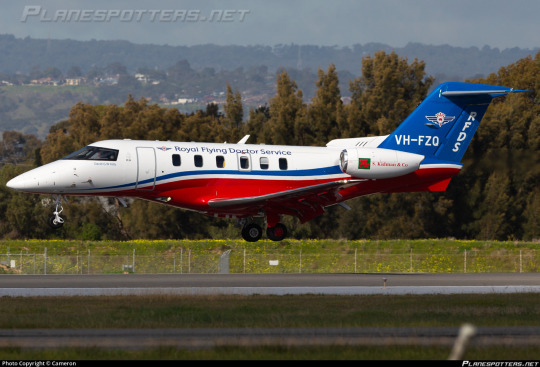
#tarmac fashion week#grade: c#region: oceania#region: australia#era: 2010s#era: 2020s#(earliest use of this livery I could find was 2013 but I'm sure it's older)#royal flying doctor service#non airline liveries#requests
26 notes
·
View notes
Text
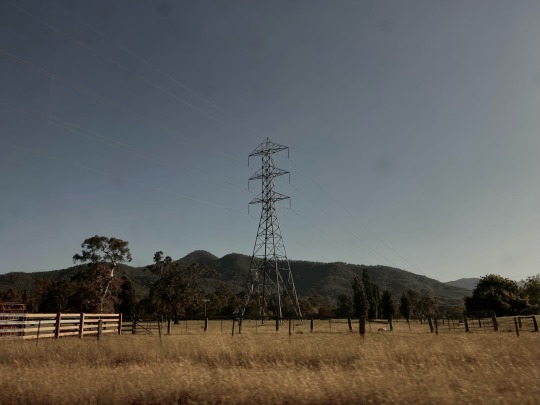
when i was a lil kid i thought these were the angels my nanna always told me were watching over me
#mine#australian gothic#regional gothic#australia#small town gothic#rural gothic#victorian gothic#small town life#small town aesthetic#small town photography#small town vibes#small town girl#small town#rural core#rural australia#ruralcore#rural aesthetic#rural landscape#rural photography#rural decay#rural life#rural#power lines#transmission tower#photographer#photography#photographers on tumblr#pylon#electricity pylon
6K notes
·
View notes
Text
This is also a bit of a culture query, cos these are all in my house so I genuinely cook with these all (except chicken salt, that's been in my cupboard for ages)
But I'm not from the USA and most people here are, so I wonder if that's similar! Maybe your cupboard is identical to mine. Maybe we use the same stuff but call it something else. Maybe USA has a different relationship with pre mix spices and you use none of it. Maybe you've never heard of pre mix spices. I dunno. That's why I'm asking!
I use plain herbs and spices as well. Especially when making a complex meal I'll do it myself. But I use pre mixes other times, so I'm voting. Voting for a pre mix doesn't mean you don't also use paprika! If you genuinely have no pre mixes in the kitchen tho, then hell yeah, tell me!
Also, I know I haven't listed everything in the world. One, that's impossible. Two, this is a bit of a culture thing so I just checked my kitchen and used those. This selection is representative of me only
(you don't have to be from the USA to vote, obvs, we just all know that's how the results will end up. Please tell me about your spice mixes in other countries!!)
Morrison spice blend: Pepper, tumeric, ginger, cardamom, parsley, salt
Chinese five spice: Star anise, cinnamon, clove, fennel, Sichuan pepper
Chicken salt: Salt, chicken stock, garlic, paprika, pepper, onion, celery
Gluhwein gewurz: Orange peel, cinnamon, lemon peel, star anise, hibiscus, clove
Chimichurri: parsley, garlic, oregano, vinegar, chilli, salt, pepper
Za'atar: thyme, cumin, coriander, sesame seeds, sumac, salt, chilli
Garam masala: coriander, cumin, cardamom, cloves, pepper, cinnamon, nutmeg
#food mention#poll#polls#spices#cooking#my gut instinct says I'm going to be told about some seasonal pumpkin spice blend for the next week#but we don't have that here so I'm not preempting and it's not going on the poll#that a regional thing! that's not in Australia! I'm standing my ground#and hey maybe I'll be wrong#if you're interested i use zaatar more than anything else#it's gentle#goes well in breakfast food when I'm cooking lazy
4K notes
·
View notes
Text


#australian gothic#my pics#victoria#victorian gothic#regional gothic#rural decay#rural australia#rural gothic#photography#small town#small town gothic#reigonal#reigonal australia
487 notes
·
View notes
Text
Gudda Gumoo Gorge, Blackdown Tableland, Australia: Blackdown Tableland is a national park in the Central Highlands Region, Queensland, Australia. The park is in Central Queensland, 576 km northwest of Brisbane. The Blackdown Tableland is a 900 m sandstone plateau rising abruptly from the plains below. Many creeks on the Tableland have developed gorges and waterfalls along their courses, the most notable of which drains in to the spectacular Rainbow Falls (Gudda Gumoo) over a 40 m drop. Wikipedia
#Gudda Gumoo Gorge#Rainbow Falls#Blackdown Tableland National Park#Central Highlands Region#Queensland#Australia#Oceania#Oceania continent
429 notes
·
View notes
Text
Shark Bay, Australia: This critically endangered giant white spotted wedgefish leads a school of juvenile golden trevally, several cobia, and others along the shallow waters of Shark Bay, Australia. .. Shark Bay is a World Heritage Site in the Gascoyne region of Western Australia. The bay features Australia's most abundant marine ecosystems. It is a popular fishing spot. Wikipedia
#shark bay#UNESCO World Heritage Site#Gascoyne region#western australia#australia#oceania#oceania continent
377 notes
·
View notes
Text

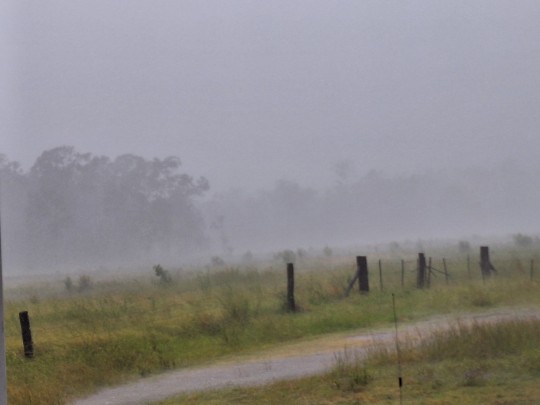

downpour
264 notes
·
View notes
Text


can you hear it talk? is it speaking to you?
#digital camera#power lines#ruralcore#regional gothic#rural aesthetic#rural gothic#rural australia#australia#new south wales
164 notes
·
View notes
Text

great southern skies | albany | western australia
#scenes from a moving car#photographers on tumblr#western australia#australia#original photographers#landscape#landscape photography#lensblr#photography#nature photography#nature#imiging#female photographers#sunset#sky#purple#orange#silhouette#great southern wa#great southern region#albany#albany wa#cloudcore#clouds
221 notes
·
View notes
Text
Wet Beast Wednesday: box jellyfish
Jellyfish are curious things, but some are curiouser than others. Most jellyfish are members of the class Scyphozoa, which is a very diverse clade with plenty of jellies to choose from. But then there are the Cubozoa, a separate class of jellyfish that have a lot of interesting and unique features, such as being some of the most venomous animals in the world. Try not to get stung.

(Image: a box jellyfish. It is a mostly translucent jellyfish with a box-shaped bell. From the corners of the bell hand four tentacles that are a striped white and orange. End ID)
Like the Scyphozoa, the approximately 50 known species of box jellyfish have a body plan consisting of a bell and trailing tentacles. While the Scyphozoa have round bells, box jellyfish have cuboid bells, which give them their name. At each lower corner of the bell is a stalk that leads into one or more tentacles. The interior of the bell is divided into four regions by structures called septa. In each region is a gastric pocket that helps direct food into the central stomach and has structures that help water flow into and out of the animal. Each septa is lined with digestive filaments and two of the jellyfish's eight gonads. In the center of the bell is a flexible, trunk-like appendage called the manubrium which contains the mouth and stomach. When thebox jellyfish eats, it draws prey into the one of the septa where the digestive filaments begin digestion. The manubrium then maneuvers the mouth over to the prey and eats it. Prey is captured with the tentacles, which are lined with stinging cells called cnidocytes which contain structures called nematocysts that inject venom into prey and threats. The tentacles then help move the food into the bell. While Scyphozoa come in a variety of colors, box jellyfish are almost always translucent.

(Image: a box jellyfish, this one having a squatter bell and multiple tentacles at each corner. The manubrium is visible through the bell as a curving, trunk-like structure. End ID)
Box jellyfish have a developed nervous system consisting of two portions: the nerve ring and the rhopalia. The ring nerve stretches around the base of the bell and controls how it moves. The rhopalia is a system of nerves that controls sensory structures. In particular, it controls a sense of gravity and the eyes. While some Scyphozoa have simple light-sensing eyes, the box jellyfish have true eyes with retinas, corneas, and lenses. Like the bell, the rhopalium is divided int four segments. Each segment has two true eyes as well as two simple pit eyes for detecting light levels and two simple slit eyes that likely detect movement. The true eyes can be oriented in different directions and they always appear to keep one pair pointing up. Thanks to their good eyesight and the shape of the bell allowing for rapid bursts of speed, the box jellyfish can actively hunt its prey instead of just drifting and waiting for food to come to them. What's more impressive is their ability to actively navigate their environment and learn to avoid certain threats. It was long thought that animals without brains would not be able to truly learn, but multiple types of cnidarians have shown learning behavior, with the box jellyfish seeming to be the most advanced.
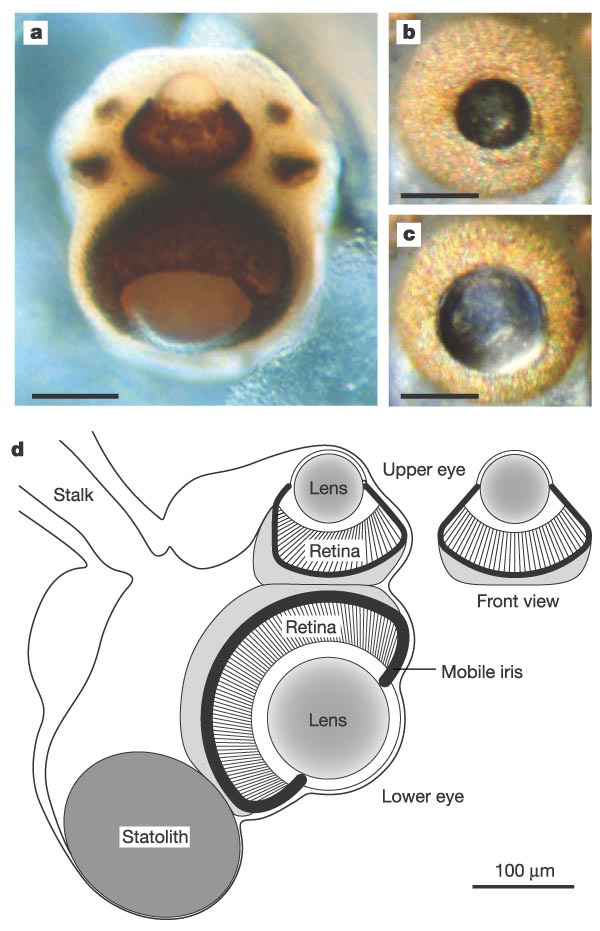
(Image: a scientific diagram showing pictures of a box jellyfish eye and a drawing of its anatomy. End ID. Source)
Box jellyfish reproduce every year and are semelparous, meaning they only mate once before dying. However, there is some inconclusive evidence that the species Chiropsalmus quadrumanus may be able to mate multiple times. Reproduction can be both internal and external depending on species. In external reproduction, the male and female release gametes into the water. In internal reproduction, the pair will maneuver themselves so the openings of their bells face each other and the male will pass a packet of sperm to the female. In these species, the female retains the eggs internally until they hatch. The juveniles hatch as a type of swimming larva called a planua. The planua will eventually settle and become fixed to a hard surface, metamorphosing into a polyp. The polyp is a non-swimming stage found in all members of the clade Medusuzoa, of which the box jellyfish are a member. Polyps will grow for months to years and during this period, they can reproduce asexually by budding off clones of themselves. Eventually, the polyps will metamorphose into the adult medusa stage

(Image: photos of a box jellyfish at different stages of its life cycle. It starts as a bean-shaped planula, progresses to a worm-like creeping polyp, then to an anemone-like sedentary polyp, then to a newly released medusa, which looks like a tentacle-less box jellyfish. The medusa them matures to a small juvenile and finally a mature adult. end ID)
Box jellyfish are found worldwide in tropical waters, though most known species are from the Indo-Pacific. It is likely that many species ave been overlooked as their transparency and frequently small size makes it easy to miss them. New studies using e-DNA, DNA that is shed and collected through the environment, may help identify nee species and populations. Box jellyfish are known to most people as being some of the most venomous animals in the world, but only a few species are dangerous to humans. The species Chironex fleckeri is the most dangerous to humans. Its venom causes extreme pain and can lead to death within 2-5 minutes if enough venom enters the system. C. fleckeri has caused over 60 recorded deaths in Australia (because where else would it live?) and while there is now an antidote to the venom, getting it to the victim fast enough can be challenging. A singe C. fleckeri is often said to carry enough venom to kill 60 people. Most reported cases of stings have not ended in death as not enough venom was introduced to the system. Also from Australia (of course) are the Irukandji, a group of about 16 similar box jellyfish that can also be lethal, but while C. fleckeri at least has the decency to be big, the Irukandji jellyfish are all tiny. Their venom causes a reaction called Irukandji syndrome that is delayed for up to 2 hours after the sting and can lead to cardiac arrest if not treated. Jellyfish nets are common sights on Australian beaches. They enclose parts of the water with nets that have mesh small enough to keep most jellyfish out. Application of vinegar to the sting is the current recommended treatment and many beaches in Australia are required to stock it, though some research has indicated that vinegar may actually make the sting worse.

(Gif: footage of the rare spotted box jellyfish. It has a large bell with stripes and rings on it and the tentacles are thick and reddish. It is swimming, showing off the movement of the bell in how it propels itself. End ID)
#wet beast wednesday#I wanted to make a fakemon based on these for my australia region#but couldn't think of anything that tentacruel and nihilego haven't covered already#box jellyfish#jellyfish#cubozoa#medusozoa#cnidarian#invertebrates#invertblr#venomous#marine biology#biology#ecology#zoology#animal facts#educational#informative#image described
179 notes
·
View notes
Text
No. 39 - Qantas

...huh. Well, today I learned Qantas is actually an acronym for Queensland and Northern Territory Aerial Services. The more you know!

Qantas, the flag carrier of Australia, is the biggest fish I've covered so far. Yes, bigger than Lufthansa. Qantas is one of the airlines. They're the second-oldest continuously operating airline in the world, they're often mistakenly claimed to have had no fatal crashes (they have never lost a plane or a passenger in the crash of a jet, but had several fatal crashes prior to 1951), and they have a dinosaur named after them.
They didn't make a commemorative livery for the Qantassaurus. I just don't understand that.
Now, they do have a handful of special liveries that I will cover in the future, because they're very interesting. They also have some significantly less interesting older liveries. But today I'm only here to talk about their default livery, the one they're using today.
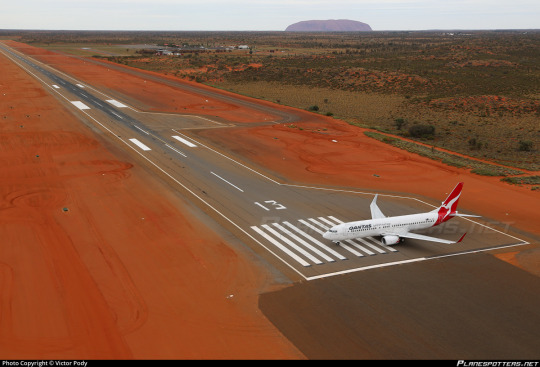
I'm honestly exhausted.

So the first thing that I need to mention is that this is Lufthansa-shaped. Lufthansesque. This isn't even that long-looking of a plane but already the detachedness of the tail is really noticeable. In its defense, Lufthansa was ripping Qantas off and not the other way around - this livery was introduced all the way back in 1984, making it truly ahead of its time. Unfortunately, it was a massive downgrade from the earlier quite cromulent 707 liveries.



The tail isn't exactly consistent. Some have no trim at all, some have a very thin grey line, and some have this decent-looking layered grey shading, and it seems completely inconsistent across models and times. Not that it would have improved my opinion tangibly, but I can't even actually count it.

You know what's strange? I have to hand it to Qantas - their logo, the silhouette of the kangaroo, is well-designed, recognizable, and I would go so far as to say iconic. But look at that graceful bit of grey shading on it. It's on the newer airplanes, but it's so subtle you might easily miss it (I actually did) - they clearly know how to use shadow, so what's with the unadorned white fuselage?
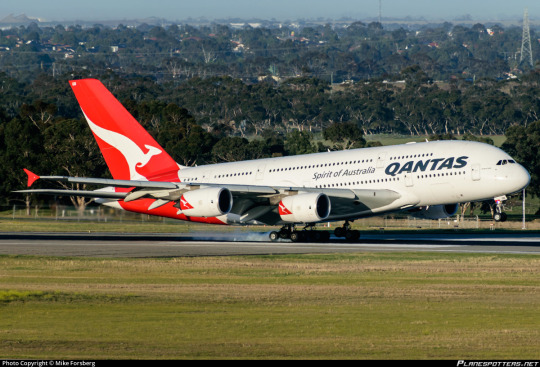
As for the font, it's definitely balanced a lot better than Lufthansa and looks very nice, but it doesn't solve the issue. Not even close. It reminds me a bit of WestJet's livery.
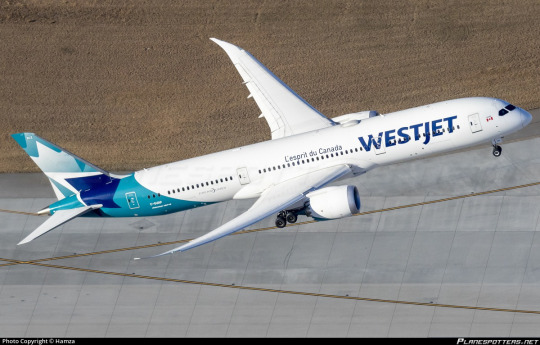
They even ripped off the 'Spirit of Australia' thing. I know you weren't involved in this, but I still blame you, David.

There just isn't much to say about Qantas, unfortunately. I think I like the little cut-ins on the engines. I like the logo. I just think they should have got around to designing an actual livery at some point. Such a storied airline owes it to themself, and they owe it to me even more.
Final grade: D+.

#tarmac fashion week#era: 1980s#era: 1990s#era: 2000s#era: 2010s#era: 2020s#grade: d+#region: oceania#region: australia#qantas#flag carriers#lufthansa line
24 notes
·
View notes
Text



these dirt roads are empty, the ones we paved ourselves
#mine#i love frankston n mount eliza#they don’t deserve the inter peninsula hate#australian gothic#regional gothic#mornington peninsula#australia#peninsula gothic#small town gothic#victorian gothic#rural gothic#small town#small town photography#small town vibes#small town girl#small town aesthetic#small town life#rural core#rural australia#ruralcore#rural aesthetic#rural landscape#rural photography#rural decay#rural life#rural#ethel cain aesthetic#ethel cain#ethel cain core#farmers daughter
2K notes
·
View notes
Text

Daily Nagoriyuki 21082024
#daily nagoriyuki#nagoriyuki#guilty gear#To me penguins are inherently cold region animals and then I sometimes remember you can find them also in places like NZ or Australia#I think that’s pretty wild
109 notes
·
View notes
Text
Aunura day?

So yesterday (26th of January) was Australia day, and yeah it's not something i'm particularly interested in, but i love thinking of weird aunura region headcanons ^^;
Okita the dorkestra is holding a lamington (real cake that's made here) and a silly flag based on The Simpsons' boot flag lol.
29 notes
·
View notes
Text


#my pics#australian gothic#victoria#victorian gothic#regional gothic#rural decay#rural australia#rural gothic#abandoned#small town#small town gothic#rural australia gothic#rural town#photography#regional town#regional town gothic#regional australia
285 notes
·
View notes
Text

Bungle Bungle Range, Australia: The Bungle Bungle Range is a major landform and the main feature of the Purnululu National Park, situated in the Kimberley region of Western Australia. The distinctive beehive-shaped towers are made up of sandstones & conglomerates. These sedimentary formations were deposited into the Red Basin 375 to 350 million years ago, when active faults altered the landscape. The combined effects of wind from the Tanami Desert and rainfall over millions of years shaped the domes. Wikipedia
#Bungle Bungle Range#Purnululu National Park#Kimberley region#Western Australia#australia#oceania continent
151 notes
·
View notes